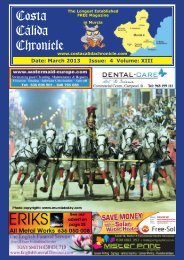Costa Cálida Chronicle - Costa Calida Chronicle
Costa Cálida Chronicle - Costa Calida Chronicle
Costa Cálida Chronicle - Costa Calida Chronicle
You also want an ePaper? Increase the reach of your titles
YUMPU automatically turns print PDFs into web optimized ePapers that Google loves.
In association with <strong>Costa</strong> Cálida International Radio and www.angloINFO.com<br />
The letter Q in<br />
Spanish does<br />
exactly the<br />
same thing as<br />
it does in English,<br />
that is, it<br />
always appears<br />
in combination<br />
with the letter<br />
U. However,<br />
the pronunciation<br />
in the two<br />
languages is different.<br />
Whereas in English “qu” makes a “kw”<br />
sound, in Spanish it makes just the “k” sound<br />
alone. So, for example, cheese is pronounced<br />
like “keso” and not “kweso”. That’s why that<br />
question that Manuel always used to ask in<br />
Fawlty Towers is spelt “¿qué?”<br />
If you remember back to the rules for pronouncing<br />
the letter C, you will know that the<br />
combination of “ce” and “ci” produce a “th”<br />
sound. Therefore whenever we need to write<br />
down a “ke” or “ki” sound in Spanish, we have<br />
to remove the C and replace it with a “qu”.<br />
That might sound a bit complicated so here’s<br />
a practical example. “Tabaco”, meaning tobacco,<br />
is spelt with a C which makes the “k”<br />
sound, however the word for a tobacconist is<br />
“tabaquero”, pronounced “tabakero”. Because<br />
the following vowel has changed from<br />
an O to an E, the C has to change to a “qu”<br />
to preserve the same “k” sound. If we kept<br />
the letter C there, it would end up being pronounced<br />
“tabathero”. That’s the best explanation<br />
I can manage I’m afraid, so it’ll have<br />
to do!<br />
Page 30<br />
I couldn’t find quite so many related words<br />
as usual beginning the QU in both languages.<br />
Here are a few recognisably similar ones:<br />
“química” (chemistry), “quimioterapia”,<br />
(chemotherapy), and “quiropractía” (chiropractic).<br />
Out of curiosity you might be interested<br />
to know that cockerels in Spain do not<br />
say “cock-a-doodle-do”, but “quiquiriquí”,<br />
although I don’t know if anyone has told the<br />
cockerels this!<br />
I was more successful in finding some “false<br />
friends” or as I prefer to call them “estranged<br />
cousins”. For example, the verb “quitar”<br />
means “to remove” and not “to quit”. From<br />
this word “quitar” we get some interesting<br />
combinations, all connected with removing<br />
something, for example: “quitamanchas”<br />
(stain remover), “quitaesmalte” (nail varnish<br />
remover), “quitamiedos” (lit. fear-remover,<br />
and meaning railings in high or dangerous<br />
places) “quitanieves” (snow plough),<br />
“quitasol” (sun shade), “quitapenas” (lit.<br />
pain or sadness remover, and meaning spirits<br />
or liquor), “quitasueños” (lit. sleep-remover,<br />
and meaning worry or anxiety that keeps you<br />
awake at night).<br />
Another false friend is “quieto” which means<br />
(still) and not “quiet”. For example, when a<br />
Spanish person tells a child to keep still, they<br />
say “¡Estáte quieto!” The word in Spanish<br />
for (quiet) is “callado”, for example: (He’s<br />
a very quiet child) is “Es un niño muy callado”.<br />
One of the most useful words ever in Spanish<br />
has been referred to already, that is “que”.<br />
It can mean “What?” as a question, in which<br />
case it has to be spelt with an accent “Qué”.<br />
“¿Qué quieres?” (What do you want?).<br />
Without the accent it can mean “what” in an<br />
embedded question. “¿Le pregunté que<br />
quería?” (I asked him what he wanted).<br />
Even more usefully it can mean “that” in a<br />
multitude of different contexts when two parts<br />
of a sentence are being joined together. “Voy<br />
a decirle que no quiero jugar” (I’m going<br />
to tell him that I don’t want to play). It comes<br />
up in many short phrases: “Creo que sí” (I<br />
think so); “Creo que no” (I don’t think so).<br />
Again with the accent<br />
it can also been used<br />
to make exclamations,<br />
and this particular aspect<br />
bears spending<br />
a bit more time on.<br />
I am a great fan of<br />
exclamations because<br />
they are short,<br />
they connect to other<br />
people very easily,<br />
they express emotion<br />
as well as ideas and<br />
they are very simple<br />
to form. For example<br />
“¡Qué horror!” means (How awful!); “¡Qué<br />
pena!” means (What a pity!) and “¡Qué<br />
asco!” means (How disgusting!), all short and<br />
sweet and highly expressive.<br />
We have a variety of different ways to formulate<br />
exclamations in English. For example,<br />
we use “What a …” with nouns (What a<br />
nuisance! What a noise!), we use “How …”<br />
with adjectives (How pretty! How gorgeous!)<br />
and we also use negative question forms<br />
like this: “Isn’t it interesting!”, “Aren’t you<br />
clever!”, “Weren’t they funny!” To cover all of<br />
these vagaries in English we simply use “Qué<br />
…” in Spanish, which makes exclamations incredibly<br />
easy to produce. Here are two more<br />
very common examples: “¡Qué calor!” (literally<br />
“What heat!”, but we would say “Isn’t it<br />
hot!”) and “¡Qué frío!”, (literally “What cold!”<br />
but we would say “Isn’t it cold!”).<br />
Here too are the translations of the English<br />
phrases above, just to prove that I’m not<br />
making all this up. (What a nuisance!) “¡Qué<br />
lata!”; (What a noise!) “¡Qué ruido!”; (How<br />
pretty!) “¡Qué bonito”; (perhaps, Isn’t she<br />
pretty!) “¡Qué guapa!”; (How gorgeous!)<br />
“¡Qué precioso!” (or sometimes “¡Qué preciosidad!”);<br />
(Isn’t it interesting!) “¡Qué<br />
interesante!”; (Aren’t you clever!) “¡Qué<br />
listo!”; (Weren’t they funny!) “¡Qué graciosos!”<br />
Just one extra point on this subject; if we wish<br />
to combine a noun and an adjective in an exclamation<br />
we do this using the word “más”.<br />
For example: (What a nice woman!) “¡Qué<br />
mujer más simpática!”<br />
Notice that the adjectives are susceptible as<br />
usual to masculine, feminine, singular or plural<br />
changes, and also notice that in the written<br />
form we open the exclamations with an<br />
“upside down” exclamation mark. Practically<br />
all nouns and adjectives could be used as exclamations,<br />
simply by adding “Qué”, which I<br />
think is rather neat, and should give you hours<br />
of fun thinking up your own!<br />
To finish off, as usual, I have a popular saying<br />
with a Q-word in it. It is: “querer es poder”,<br />
which literally translates as “to want is to<br />
be able”, and is the equivalent of our English<br />
saying: “Where there’s a will there’s a way”.<br />
I hope that’s your attitude when it comes to<br />
learning Spanish!<br />
Jane Cronin, Spanish Classes and Talks.<br />
www.janecronin.eu Tel: 968183258<br />
Try working out the Wordsearch on page ? using<br />
words beginning with the letter Q.<br />
Please tell our customers where you saw their advertisement in the <strong>Costa</strong> Cálida <strong>Chronicle</strong><br />
To place an advertisement with us please see page 5 or contact Teresa 619 199 407<br />
www.costacalidachronicle.com<br />
email: costacalidachronicle@gmail.com
















